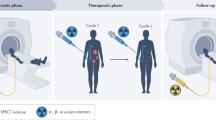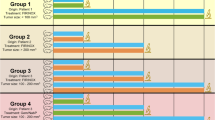Abstract
Rapid assessment of cancer response to a therapeutic regimen can determine efficacy early in the course of treatment. Although biopsies of cancer can be used to rapidly assess pharmacodynamic response, certain disease sites are less accessible to repeated biopsies. Here, we simultaneously assess response in all sites of disease within days of starting therapy by use of peptide ligands selected for their ability to discern responding from nonresponding cancers. When conjugated to near-infrared imaging agents, the HVGGSSV peptide differentiates between these two types of cancer. Rapid, noninvasive assessment of the pharmacodynamic response within cancer promises to accelerate drug development and minimize the duration of treatment with ineffective regimens in cancer patients.
This is a preview of subscription content, access via your institution
Access options
Subscribe to this journal
Receive 12 print issues and online access
$209.00 per year
only $17.42 per issue
Buy this article
- Purchase on Springer Link
- Instant access to full article PDF
Prices may be subject to local taxes which are calculated during checkout




Similar content being viewed by others
References
Prenen, H. et al. Efficacy of the kinase inhibitor SU11248 against gastrointestinal stromal tumor mutants refractory to imatinib mesylate. Clin. Cancer Res. 12, 2622–2627 (2006).
Kabbinavar, F. et al. Phase II, randomized trial comparing bevacizumab plus fluorouracil (FU)/leucovorin (LV) with FU/LV alone in patients with metastatic colorectal cancer. J. Clin. Oncol. 21, 60–65 (2003).
Motzer, R.J. et al. Activity of SU11248, a multitargeted inhibitor of vascular endothelial growth factor receptor and platelet-derived growth factor receptor, in patients with metastatic renal cell carcinoma. J. Clin. Oncol. 24, 16–24 (2006).
Motzer, R.J. et al. Sunitinib in patients with metastatic renal cell carcinoma. J. Am. Med. Assoc. 295, 2516–2524 (2006).
Narula, J. et al. Annexin V imaging for noninvasive detection of cardiac allograft rejection. Nat. Med. 7, 1347–1352 (2001).
van de Wiele, C. et al. Quantitative tumor apoptosis imaging using technetium-99m–HYNIC annexin V single photon emission computed tomography. J. Clin. Oncol. 21, 3483–3487 (2003).
Belhocine, T. et al. Increased uptake of the apoptosis-imaging agent 99mTc recombinant human Annexin V in human tumors after one course of chemotherapy as a predictor of tumor response and patient prognosis. Clin. Cancer Res. 8, 2766–2774 (2002).
Ladner, R.C. Polypeptides from phage display. A superior source of in vivo imaging agents. Q. J. Nucl. Med. 43, 119–124 (1999).
Rusckowski, M. et al. Inflammation and infection imaging with a 99mTc-neutrophil elastase inhibitor in monkeys. J. Nucl. Med. 41, 363–374 (2000).
Arap, W. et al. Steps toward mapping the human vasculature by phage display. Nat. Med. 8, 121–127 (2002).
Pasqualini, R. & Ruoslahti, E. Organ targeting in vivo using phage display peptide libraries. Nature 380, 364–366 (1996).
Ruoslahti, E. Vascular zip codes in angiogenesis and metastasis. Biochem. Soc. Trans. 32, 397–402 (2004).
Scott, J.K. & Smith, G.P. Searching for peptide ligands with an epitope library. Science 249, 386–390 (1990).
Hallahan, D. et al. Integrin-mediated targeting of drug delivery to irradiated tumor blood vessels. Cancer Cell 3, 63–74 (2003).
Schueneman, A.J. et al. SU11248 maintenance therapy prevents tumor regrowth after fractionated irradiation of murine tumor models. Cancer Res. 63, 4009–4016 (2003).
Han, Z., Xiong, C., Mori, T. & Boyd, M.R. Discovery of a stable dimeric mutant of cyanovirin-N (CV-N) from a T7 phage–displayed CV-N mutant library. Biochem. Biophys. Res. Commun. 292, 1036–1043 (2002).
Wrighton, N.C. et al. Small peptides as potent mimetics of the protein hormone erythropoietin. Science 273, 458–464 (1996).
Morgan, B. et al. Dynamic contrast-enhanced magnetic resonance imaging as a biomarker for the pharmacological response of PTK787/ZK 222584, an inhibitor of the vascular endothelial growth factor receptor tyrosine kinases, in patients with advanced colorectal cancer and liver metastases: results from two phase I studies. J. Clin. Oncol. 21, 3955–3964 (2003).
Hess-Stumpp, H., Haberey, M. & Thierauch, K.H. PTK 787/ZK 222584, a tyrosine kinase inhibitor of all known VEGF receptors, represses tumor growth with high efficacy. ChemBioChem 6, 550–557 (2005).
Wood, J.M. et al. PTK787/ZK 222584, a novel and potent inhibitor of vascular endothelial growth factor receptor tyrosine kinases, impairs vascular endothelial growth factor–induced responses and tumor growth after oral administration. Cancer Res. 60, 2178–2189 (2000).
Drevs, J. et al. PTK787/ZK 222584, a specific vascular endothelial growth factor–receptor tyrosine kinase inhibitor, affects the anatomy of the tumor vascular bed and the functional vascular properties as detected by dynamic enhanced magnetic resonance imaging. Cancer Res. 62, 4015–4022 (2002).
Yazici, S. et al. Dual inhibition of the epidermal growth factor and vascular endothelial growth factor phosphorylation for antivascular therapy of human prostate cancer in the prostate of nude mice. Prostate 65, 203–215 (2005).
Traxler, P. et al. AEE788: a dual family epidermal growth factor receptor/ErbB2 and vascular endothelial growth factor receptor tyrosine kinase inhibitor with antitumor and antiangiogenic activity. Cancer Res. 64, 4931–4941 (2004).
Mendel, D.B. et al. In vivo antitumor activity of SU11248, a novel tyrosine kinase inhibitor targeting vascular endothelial growth factor and platelet-derived growth factor receptors: determination of a pharmacokinetic/pharmacodynamic relationship. Clin. Cancer Res. 9, 327–337 (2003).
Sun, L. et al. Discovery of 5-[5-fluoro-2-oxo-1,2-dihydroindol-(3Z)-ylidenemethyl]-2,4-dimethyl-1H-pyrrole-3-carboxylic acid (2-diethylaminoethyl)amide, a novel tyrosine kinase inhibitor targeting vascular endothelial and platelet-derived growth factor receptor tyrosine kinase. J. Med. Chem. 46, 1116–1119 (2003).
Hallahan, D.E. & Han, Z. Biopanning for phage-displayed peptides binding in treated tumors. Nat. Protoc. published online, doi:10.1038/nprot.2008.24.
Acknowledgements
This work was supported by US National Cancer Institute grants R01-CA89674, R01-CA112385 and R01-CA125757 (D.E.H.) and the Ingram Charitable Fund and the Vanderbilt-Ingram Cancer Center. We thank E. Ruoslahti (Burnham Institute) for the gift of T7 phage–based random peptide library and A. Kraker and P. Bailey (Pfizer) for technical assistance with mouse models of cancer.
Author information
Authors and Affiliations
Contributions
Z.H. and A.F. discovered and prioritized peptides. A.F., R.D. and H.O. performed all mouse imaging. H.W. and L.G. performed cell assays microscopy and histology. D.E.H. is the principle investigator and oversaw all studies.
Corresponding author
Ethics declarations
Competing interests
A patent application to the US Patent Office entitled “Imaging cancer response by use of peptide ligands” is pending.
Supplementary information
Supplementary Text and Figures
Supplementary Figs. 1–3 and Supplementary Methods (PDF 12300 kb)
Rights and permissions
About this article
Cite this article
Han, Z., Fu, A., Wang, H. et al. Noninvasive assessment of cancer response to therapy. Nat Med 14, 343–349 (2008). https://doi.org/10.1038/nm1691
Received:
Accepted:
Published:
Issue Date:
DOI: https://doi.org/10.1038/nm1691
This article is cited by
-
Synthesis, characterization, in vitro and in vivo studies of dextrin-coated zinc-iron ferrite nanoparticles (Zn0.5Fe0.5Fe2O4) as contrast agent in MRI
Applied Physics A (2015)
-
Phage display peptide probes for imaging early response to bevacizumab treatment
Amino Acids (2011)
-
Multifunctional FePt Nanoparticles for Radiation-Guided Targeting and Imaging of Cancer
Annals of Biomedical Engineering (2011)
-
Quantitative analysis of cell tracing by in vivo imaging system
Journal of Huazhong University of Science and Technology [Medical Sciences] (2010)
-
Advances in Cancer Therapeutics
Clinical Pharmacology & Therapeutics (2009)



